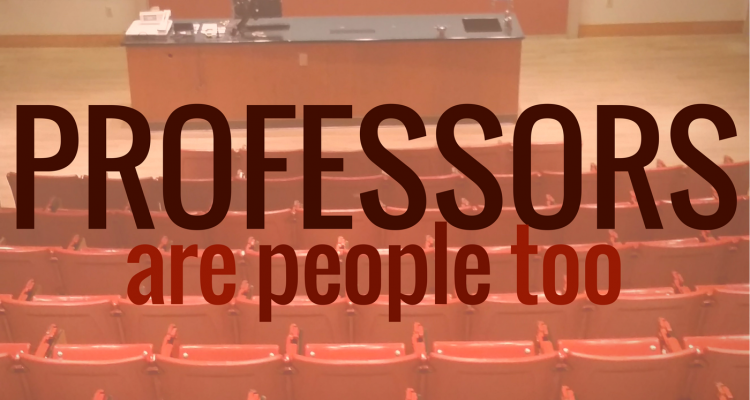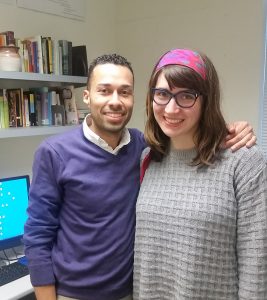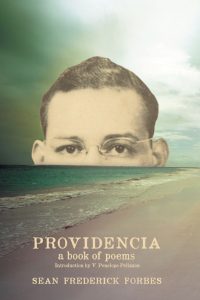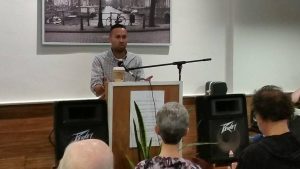The Episode
So here’s the big reveal, Ali’s not the only one behind Professors Are People Too! Sean Forbes, an Assistant Professor-in-Residence and the Director of Creative Writing, is Ali’s podcast advisor. Week-to-week, Ali and Sean meet, they talk about writing, horoscopes, and obviously, the podcast! But while Ali’s busy making the first two episodes, Sean’s making a little art of his own. Ali ventures beyond their weekly meetings and finds that everyone’s got a lesson to teach and a lesson to learn.
The Podcast
Professors Are People Too is a show hosted by an English major looking to find the person behind the Ph.D. Trying to rebuild the professor-student relationship, host Ali Oshinskie takes us on a tour of the professors who transformed her learning experience from lecture-hall lost to office-hour happy. In collaboration with University of Connecticut’s English Department and WHUS, UConn’s Sound Alternative, this podcast ventures off the syllabus into lessons that can’t be graded.
Other Episodes!
Episode 5: Victoria Ford Smith
Episode 4: Dwight Codr
Season 2: Introduction
Episode 3: Sean Forbes
Episode 2: Cathy Schlund-Vials
Episode 1: Gina Barreca
Please subscribe in iTunes, Stitcher, Google Play or wherever you get your podcasts. So many options!
The People
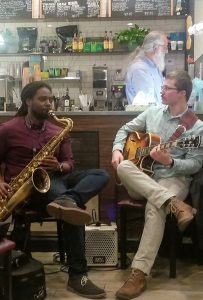
My boyfriend, Pawel and his friend, Miguel playing at Sean’s reading for The West End Poetry Society at the Metro Cafe in Hartford, CT.
The Music
- Sean Forbes–“I’m Deaf”, Check out more of Sean’s music at www.deafandloud.com
- Podington Bear–Intermezzo
- Podington Bear–Undersea Garden
- Pawel Kostyk, originally by Jack Strachey–These Foolish Things (Remind Me Of You), Check out his SoundCloud!
- Podington Bear–Memory Wind
- Podington Bear–Plastique
- Podington Bear–Dimlight
The Transcript
ALI OSHINSKIE, HOST: In this episode of People are Professors Too…
[RECORD SCRATCH]
Wait what? You heard me. People are professors too because in this episode I’m taking you to the professor who I first knew as a person and then as a professor. Meet the man behind the podcast, the poetic, the professional and the personable, Sean Frederick Forbes.
[MUSIC IN]
SEAN FORBES: And there’s a reason why in the literary world, I’m known as Sean Frederick Forbes. There’s a hearing impaired rapper and poet by the name of Sean Forbes out of Detroit. We were both born in the same year. We spell our names the same way. So we’re often confused by people who are looking for him and they’ll send me an email, and I’m thinking, “no, you have the wrong Sean Forbes.” So in order to differentiate between the two, I decided to publish under Sean Frederick Forbes.
OSHINSKIE: I’m Ali Oshinskie and this is Professors are People Too.
RECORDING of OSHINSKIE: We don’t see the human in our professors and for good reason.
FORBES: So what happened there?
OSHINSKIE: Yeah, so you kind of heard the three disjointed things in there, right? And that’s kind of what I’m still considering.
OSHINSKIE: This is Sean and I talking about the podcast.
FORBES: Actually, this might be a blessing in disguise.
OSHINSKIE: Yeah?
OSHINSKIE: Sean’s my advisor for the podcast. He’s an Assistant Professor-in-Residence and the Director of Creative Writing. When he agreed to work with me on the podcast, I’m not sure either of us knew what we were really getting into. So here’s a little back story. In August, I approached Ruth Fairbanks of the Writing Internship Program and said, “I want to make a podcast for the English Department.” And I wanted to get academic credit for it. We worked out the logistics of the credit, and the next thing I knew I was in Professor Fairbank’s office with this young, handsome, caramel-skinned professor. It’s Professor Forbes and he’s going to be my advisor. We figured out everything, and as I was leaving, I said, “Thank you, Professor Forbes. I’m so excited to work with you.” And he responds —
FORBES: Just call me Sean.
OSHINSKIE: Okay, Sean. I’m going to call him Sean. I was so excited. Professor — no, Sean — is going to guide me through this podcast. He’s young and hip, and he also likes Invisibilia which is, like, my favorite podcast too. So in the first week of classes, I go to his office hours or no, it’s our podcast meeting but it’s in his office. And it’s also like a class because I’m getting credit for it but we’re not in a classroom. Regardless, I’m all about it because I don’t know if you’ve figured it out by now, but I love office hours. And we get to have office hours every week! But I had the idea that our weekly meetings would be more like a mini classroom. He would bring a lesson plan, and I’d ask questions. Sure, he’d never done a podcast before, but he teaches creative writing, how could it be that different?
[MUSIC IN]
On a weekly basis, I would bring Sean questions.
OSHINSKIE: Are there any ideas that you have about the interview?
OSHINSKIE: And he’d pause for a minute. And then he’d say that statement that seemed to echo through the room.
FORBES: That is a good question.
OSHINSKIE: We’d talk a little more, and eventually the question would come back to me.
FORBES: What else do you want to know about him? What else do you think is intriguing about him?
OSHINSKIE: In most of our meetings, there were these moments. I’d pose a question, and we’d sit there for a minute with the “I don’t know’s.” And to be honest, I kept wondering when it was all going to kick in, when Sean would have that moment of “this is what you do” and the clouds would give way to this golden magnificent podcast, ready to go. And while I was waiting for the sky to open up, we would chat. We talked about horoscopes.
OSHINSKIE: Okay. So I’m curious to know. What’s your zodiac sign?
FORBES: Oh, I’m a Capricorn.
OSHINSKIE: What’s your favorite color?
FORBES: Blue. I always wear some shade of blue.
OSHINSKIE: You do.
OSHINSKIE: And this is where the details started to fill in. As I was telling other professor stories, I got a little bit of Sean’s. He’d illuminate some conversations with his own examples, his own teaching examples.
FORBES: I used to think that I could only write about gay, male writers or I could only write about ethnic writers, whatever ethnic means. And then I started to say well why should I limit myself in this way? Because if I’m limiting myself, then isn’t that hindering my learning experience? Because as a teacher, you don’t know everything. I really did think for a long time, “Oh, my professors know everything about literature.” No, they don’t. And I’m not going to purport to know that about — everything about literature.
OSHINSKIE: And then he told me this.
FORBES: And then there are moments where students will ask me these brilliant questions, and I have this thought pause where I’m like — I could answer this, but what if I answer it incorrectly? Or what if I don’t have the information? So I’ll just say, “Look, I’ll get back to you.”
[MUSIC IN]
OSHINSKIE: I thought about those questions, those uncomfortable room silencing questions. I started to break it down. They’re uncomfortable because I don’t have the answer. And the girl next to me doesn’t have the answer. Or anybody else in the class. And we’re sitting there looking at the professor because we’re waiting for them to give into that awkward silence and tell us. We’re waiting for them to deliver the answer because we believe that they have it, tucked away nicely in their lesson plan and poising themselves to drop the mic. But what I’m usually thinking is this.
FORBES: I could answer this, but what if I answer it incorrectly?
[MUSIC OUT]
PAWEL KOSTYK, ON PHONE: Hello?
OSHINSKIE: Hi.
KOSTYK: Hey, what’s up?
OSHINSKIE: That’s me talking to my boyfriend, Pawel.
OSHINSKIE: What are you doing this weekend?
KOSTYK: I do have — on Saturday, I’m playing at the —
OSHINSKIE: He and another friend have a jazz duo, and they play regularly at the West End Poetry Society at the Metro Café in Hartford.
OSHINSKIE: Who’s reading at it?
KOSTYK: Uh, It’s Edwina Trentham, I believe, and Sean Frederick Forbes.
OSHINSKIE: Wait, what? Sean Frederick Forbes?
KOSTYK: Yeah.
OSHINSKIE: You know who he is, right?
KOSTYK: No idea.
OSHINSKIE: He’s — Sean Forbes. He’s my podcast advisor.
[MUSIC IN]
[CAFE AMBIENT NOISE]
Okay. So I had to go to this reading. Of course, I did. I mean, to see my boyfriend but mostly to see Sean. Sorry Pawel. I had to see Sean not as just the professor but as the poet. Sean read a poem about his grandmother, and he prefaced it with this.
FORBES: Whenever she’s going to the Red Lobster in particular, she will pack a switch blade, a 50 dollar tube of Givenchy lipstick, and her rosary beads. So in one outing, she’s ready for a fight, she’s ready to meet a man, and she’s ready to meet her maker.
OSHINSKIE: After gracefully joining in on the laughter, Sean gave a slight nod, acknowledged the crowd and he began.
FORBES: Errand, 1949
Aillen in Providencia
The main road is a dirt road.
From Lazy Hill to Town it’s more
than an hour on foot, but she refuses
to ride side-saddle on her brother’s
horse. She’s wearing open-toed
high heels, her thick black hair’s
twisted into a fat chignon, her silky
floral dress clings to her stomach.
The women notice the slight bulge,
anticipating the disfigurement
of motherhood for her, while their husbands
crave the perspiration gathering in
her cleavage. She walks into the bank,
her dusty suede heels sparking
hard against the tiled floor, sweet
and sirenic. She spends fifteen
minutes writing a telegram
to her husband in Curaçao.
She pictures him kissing his mistress
and shoves the form to the clerk. He reads
the line, “That barren woman will lose
her scent. STOP. Come back.” She sees the clerk
write this down on a separate piece of paper
knowing he will give it to his wife later.
She pays the fee, refuses to thank him, and slowly
leaves the bank, cautious as a freed slave.
OSHINSKIE: Sean’s poetry flowed with familiarity. This woman, his grandmother was he, as he worded her thoughts and actions. And we were this woman for a minute, briefly transported to Providencia. How did he do this? I read poetry with this kind of clarity before, but I always assumed it was some sort of internal knowledge, that a poet could only write like this from his experience. So how could he, not a woman in dusty suede heels, not pregnant with an absent husband, not even alive in 1949 put down in words this moment so perfectly?
FORBES: I used to think that I could only write about gay male writers or I could only write about ethnic writers.
OSHINSKIE: I guess I made that mistake of assuming the writer is narrator and vice versa. I’ve talked to professors about literature before, but I’ve never seen a professor do literature before. And I don’t think I’ve ever really met an author. In class, we talk about the motives of authors or the history behind it, and we get advice to make our own writing better. But I’ve never heard the history behind it, and known the author at the same time.
[MUSIC IN]
So I got to say, I have this weird belief that the best writers are touched with this sort of holy light, the angel of rolling ball pens and leather bound notebooks has come down and blessed them and left all us others untouched. But I still have to have some reason to hope for my own skill, right? And the best way to do that is in creative writing classes.
[MUSIC OUT]
So I went to Sean’s. In the beginning of class, Sean takes a professional stance. He gives a few announcements,
[AMBIENT NOISE]
FORBES: Ok guys, I will take whatever you have for me…
OSHINSKIE: and then retreats to a desk at the back of the room. A group of students self-motivated to the front.
[MOVEMENT NOISE]
And then their comments begin. Sean sits in silence, save his trademark
FORBES: Mhm mhm
OSHINSKIE: and at the end, he chimes in.
FORBES: Everybody said a lot of what I wanted to say…I think that’s the joy of workshops…providing some more background
OSHINSKIE: The class runs itself, and Sean seated among the students with a blue sweater and jeans is one of the workshop. And being part of the workshop, he puts himself in the position of the student. But this doesn’t make total sense to me because of something Sean told me in one of our weekly meetings.
FORBES: My experience was that I was a graduate student here from 2003 to 2011. So for my Masters and my Ph.D…and then suddenly I was hired as an adjunct in 2011 to teach creative writing courses. A year after that, I became the Acting Director of the Creative Writing program. And now I’m Assistant Professor-in-Residence as well as the Director of the Creative Writing program. And so in some ways I felt like I had to constantly prove myself and prove my abilities.
OSHINSKIE: And sometimes students want that proof too.
FORBES: I think sometimes it happens with students or it has happened with students where they’ll say to me, “You’re not really 35, are you?” Yes, I am. Do you want to see my driver’s license? “You’re too young to be teaching us. We’re looking for someone who has the tweed jacket with the patches on the elbows.” So they’re thinking about a very distinctive type of college professor. And in some ways, I don’t fit into that role for them or that vision of the college professor. So if I come into the classroom wearing jeans and sneakers, I notice that I’m treated differently by my students, automatically. The tone is very casual. They’re very chatty. They’re very talkative. And if I come into the classroom with slacks, a button down shirt and a sweater, the room goes silent.
OSHINSKIE: On that day in class, Sean wore jeans. A small choice that makes everything different from his point of view. But it’s not just his fashion choices that changed things here. Putting himself in a seat next to his students, commenting after they do, having them run the class, these techniques all seem to boil down to that piece of writing advice that everyone knows: show, don’t tell.
FORBES: It’s a way of also putting myself in the student setting once again so that I don’t ever lose the proportionality between student and professor, professor and student.
OSHINSKIE: And what is it that Sean wants to show?
OSHINSKIE: So you–Do you want to be a student there? Because that’s kind of like —
FORBES: I do want to be a student there because, you know what? Sometimes I learn some of the greatest things about or greatest aspects or elements about writing from other students who are just observing, um, aspects of let’s say a poem that I probably missed…because I was so concerned about something else.
[MUSIC IN]
OSHINSKIE: You want to keep learning?
FORBES: We always have to keep learning. If not, what’s the point of being here? I think another reason if this can provide some context is because I think as a professor or even as any type of teacher, you have to put yourself in the vulnerable position of being a student once again. And how incredibly terrifying it is for someone or many people to critique your work. And you’re not sure how they’re going to respond to it.
OSHINSKIE: Sean conducts class in his jeans. But even on days when he’s wearing a sweater and button down, he’s still a student because Sean is a lifelong learner. And being a lifelong learner means that everyone has a lesson to share. So at the end of the semester, I wanted to know what he learned from me.
OSHINSKIE: Why are you taking this class?
FORBES: Why am I taking this class? Well, why am I teaching this class?
OSHINSKIE: Why are you — why did you decide to go along with this podcast project?
FORBES: Oh, that’s a good question. I think that’s a really good question. I wanted to know a lot more about podcasts because I listen to different podcasts. And I listen to WNPR a lot, and I think to myself, “Wow, there’s so much work that goes into it, but what’s the process? How do you even begin to develop a segment?” And I don’t know what I was expecting for this project. I thought it was going to be different, spontaneous in some ways. I didn’t expect for there to be all of this revising for some reason or all of this editing, and then I realized, “Oh, wait a minute. This is like writing. This is like telling — this is telling a story.” I knew you’d be telling a story in the different segments, but I didn’t realize that the process is very similar to any act of writing.
[MUSIC IN]
I don’t know. I think if you’re a writer, and I think if you’re someone who enjoys reading as much as I do, you have to understand that you can learn things about everyday situations that sometimes you can’t find in a book or vice versa. And the same thing with class discussion. If I’m the only one who’s speaking and no one else is speaking, it’s highly problematic to me because it’s one-sided.
OSHINSKIE: So maybe Sean’s students don’t see him as the typical professor. But maybe the tweed jacket gets in the way. Maybe the tweed jacket gives us this idea that the person with the book in the front of the classroom is already that divinely illuminated writer. Sean has a different kind of glow, that of a mirror, turning around the questions that we, the students, would come to him with. We know how to run towards the tweed jackets asking “how do I do this?” And thinking that the person with the Ph.D. already has the answer. I’m sure Sean has that answer. But he’s also sure that we have it.
There’s so much love to give at the end of this episode. Thank you to Sean Forbes, the hip hop artist, not the professor, for letting me use your song, “I’m Deaf”, at the beginning of this episode. And thanks also to Pawel Kostyk, my jazz guitar playing boyfriend for playing at Sean’s reading and also for letting me use your cover of this song, “These Foolish Things (Remind Me of You).” Thanks also to Ruth Fairbanks, Jason McMullan, Danielle Chaloux, and Cathy Schlund-Vials for their help and support with this episode. And of course, thank you to Sean Forbes, the professor, the poet and the podcast advisor. This entire project has taken flight by your guidance. You knew I could even when I didn’t. And now a little bit of good news for all of you devoted listeners or new ones, Season Two is on its way! Thank you for listening, and please subscribe on iTunes or wherever you get your podcasts. And keep your eyes peeled for the next episode of —
PROFESSOR DWIGHT CODR: Professor
PROFESSOR SEAN FORBES: Professor
PROFESSOR GINA BARRECA: Professor
OSHINSKIE: Professors are People Too
[MUSIC OUT]
OSHINSKIE (singing with music): dwee di di di dip, dwee diddle de, Professors are people too, dwee dee
Thank you Sean Frederick Forbes for letting us put his poem, Errand, 1949, in this transcript!
Works Cited
Forbes Forbes, Sean Frederick. Providencia. (New York: 2Leaf Press, 2013).


